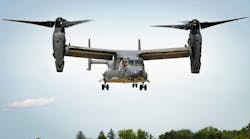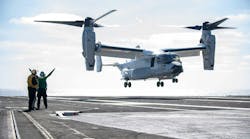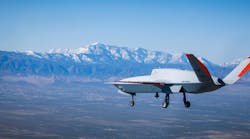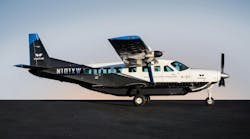June 27--In the latest setback for the Pentagon's pricey F-35 Joint Strike Fighter program, the U.S. military has grounded all of the fighter jets from flight operations after a fire that occurred at Eglin Air Force Base in Florida this week.
Flights were expected to resume the day after Monday's mishap, but the Air Force, Navy, and Marine Corps have since decided to temporarily suspend all F-35 operations until it is determined that flights can resume safely.
A military safety board has begun investigating the incident to determine the cause.
Early Monday, one of the Air Force's radar-evading, supersonic fighter jets caught fire before takeoff. The pilot left the aircraft uninjured, officials said.
The aircraft was preparing to take off on a training mission but aborted when flames appeared in the rear of the aircraft. Emergency responders then extinguished the fire with foam, according to an Air Force statement.
The 33rd Fighter Wing at Eglin provides training for F-35 pilots and mechanics for the Air Force, Navy and Marines. The wing commander temporarily suspended flying operations as a precautionary measure, before officials nationwide followed suit.
"Sadly, this is part of a larger pattern of teething issues that we've come to expect with this program," said Richard Aboulafia, an aerospace analyst with Teal Group Corp., a Virginia research firm. "It's bad, but it will be even worse if the grounding lasts more than a week or two."
More than 100 F-35s are flying at bases around the nation, including Edwards Air Force Base, about 100 miles northeast of Los Angeles.
Kyra P. Hawn, a spokeswoman in the military's Joint Program Office, said some commanders decided to suspend F-35 flight operations after news of the fire spread. However, the decision to ground all flights occurred Wednesday afternoon as more information became available.
"We are grateful that Monday's incident was contained, and that procedures were followed that prevented additional damage or injury," Hawn said.
The Joint Strike Fighter program centered around a plan to develop one basic fighter plane that could, with a few manufacturing tweaks, be used by the Air Force, Navy and Marines.
The idea is that it can take off and land on runways and aircraft carriers, as well as hover like a helicopter. No single stealthy fighter aircraft has had all these capabilities. From an engineering standpoint, it's a challenging task for plane maker Lockheed Martin Corp. because the requirements of the different services vary so much.
"Follow-on activities are providing us with the opportunity to learn how to efficiently and effectively coordinate the flow of relevant information to a diverse group of F-35 stakeholders," Hawn said.
It's a blow to the often-troubled, $400-million F-35 program, which has been under development for more than a decade. The program is billions of dollars over budget, and years behind schedule. The per-plane cost estimates have climbed to $135 million today from $78 million in 2001, according to the Government Accountability Office.
It is the most expensive weapons program in history. The GAO estimated the program would cost $12.6 billion a year on average through 2037 -- that's an average of about $1.4 million an hour for the next two and a half decades.
Ultimately, the military wants the F-35 to replace its aging fighter fleets. Some planes still in use are more than 3 decades old.
Testing is key to the Pentagon's ultimate plan to build 2,457 of the planes. Problems repeatedly crop up. On June 13, test flights were temporarily halted and mandatory inspections were ordered for all versions of the jets after a Marine F-35 experienced an in-flight emergency with its engine.
A Lockheed spokesman said that the company was aware of the incident at Eglin and was prepared to provide any assistance requested. The jet's fire has not affected any manufacturing operations.
Although the final assembly on the planes takes place in Fort Worth, there are 277 companies in California that supply the program -- far more than any other state. Subcontractors across California have spent millions of dollars preparing for what is expected to be decades of work on the F-35.
There are already foreign buyers relying on the program. Lockheed plans on selling hundreds of F-35s to the some the nation's closest military partners: Britain, South Korea, Israel, Italy, Australia, Canada, Norway, Japan, Turkey, Denmark and the Netherlands.
Despite the grounding, there are no changes to the military's plans to debut the aircraft next month in its first overseas air show at the Farnborough International Airshow in Britain. The two-day event, which opens July 19, is one of the largest aerospace showcases where plane makers, airline executives and military officials from around the world gather to sign lucrative deals.
Twitter: @wjhenn
Copyright 2014 - Los Angeles Times




